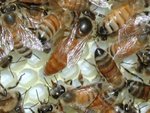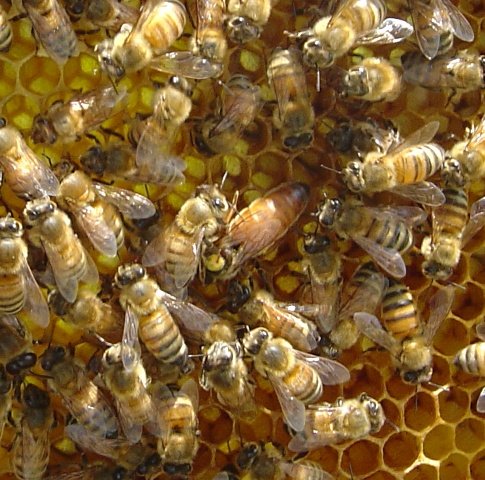My queen rearing project began out of a desire to see my bees survive the damp cape cod winters. I had been experiencing a 50% to 80% loss of colonies from year to year.
Left: Example of bee larva of various ages.
I along with many beekeepers have noticed that over the past 30 years it has been harder and harder to keep bees. I have seen winter hive looses, not to mention summer hive losses, increase year after year.
I remember when I was 17 years old with my first hive of bees. They were Starline hybrid bees, and I knew next to nothing about keeping them. The hive survived for years on its own. Now that would seldom if ever happen. A hive that is not carefully kept and attended to will probably die the first season. Trachea, and Verroa mites along with the small hive beetle, as well new bee viruses, not to mention colony collapse disorder have devastated the bee population.
 Right: Queen Pupa of the development age from different size queen cells. These queens were grafted on the same day. Their developmental variation is probably due to the age of the larva at the time they were grafted.
Right: Queen Pupa of the development age from different size queen cells. These queens were grafted on the same day. Their developmental variation is probably due to the age of the larva at the time they were grafted.In breeding and mass production of queens have weakened the genetic quality of our bees. Queens that would once last four or five years need to be replaced every two.
Left: A steady hand is needed to transfer the fragile larva from the comb into the artifical cell
So what have I done about it? Well three years ago I started learning how to raise queens of my own. With both success and failure.
2007 (year 1). I experimented with two methods of queen rearing. The miller method, and the Doolittle method. I quickly became apparent to me that the Doolittle method allowed me much more control over the queen rearing process.
Right: Larva after being grafted. These larva should be only three days old. Their various ages can bee seen by the degree of curviture of the larva. Three day old larve look like a comma. Some of these grafts appear to be 4 or 5 days old. This would result in poor quality queens.
Positive
I learned how to graft (I was dry grafting at the time) larva into artificial cells.
I learned how to create a cell starter colony
I learned how to create a cell builder colony
I learned how to create queen mating nucs.
I was able to have 10% of my grafts accepted by the cell builder colony (9 out of 90 grafts)
Good size queen cells were created by the cell builder colony
I had 8 queens emerge
Queens were of adequate size.
I had 3 queens mate and start laying
Left: Two days after grafting and being placed in a cell builder, you can see the larva floating in a pool of royal jelly. You can also see how the nurse bees have started to add wax to the plastic cell as they start creating the queen cell.
Negative
Only 10% of my grafts were accepted
No queens survived into 2008
2008 (year2). I continued to experiment with the Doolittle method of queen rearing. I started to learn more about bee genetics and the importance of the Drone (male). I took a queen rearing class and discovered that if the artificial cells were primed with royal jelly, or even plain yogurt, better grafting results could be obtained.
Left: My first queen cells from 2007. You can see how large they are. This is due to the proper age larve being grafted into the cell, and the fact that only 8 cells were accepted and fed by the nurse bees. The cell builder colony was not over whelmed by the number of queen cells.
Positive
I raised queens three times that spring.
Wet grafting of larvae improved my acceptance rate to 90%
Grafting 90 cells yielded 80 queen cells.
I raised 15 mated queens that season.
Negative
Queen cell size was very small. This was partly due to my over whelming my cell builder hives with too many queen cells. I believe that I also grafted larva that was 4 or 5 days old not 3 as I should have. This resulted in smaller cells and smaller queens.
I had a problem creating nucs. I was not as organized as I should have been. I attempted to make splits from nearby colonies. 50% of the nucs created returned home to the mother hives abandoning the queen cells and brood placed in the nuc. The previous year I had used relocated bees to create the nucs. That method worked much better.
Right: Queen cells from 2008. You can see how small the cells are. This was probably due to the number of grafts placed in the cell builder and the age of the grafted larva being too old.
I had problems with small hive beetle larva infesting two of the nucs creating a situation where the bees abandoned the nuc. This was probably due to the low numbers of bees remaining in the nucs thus creating stress within the nuc colony.
Queen quality was poor due to the small cell size. I did not attempt to over winter any of the queens.
2009 (year 3). I continued with the Doolittle method of queen rearing. It was an extremely cold wet spring. The colonies would not buildup and missed the main honey flow (May, June, and July). All the colonies were starving in August, a time where there should have been 60 pounds of surplus honey on each hive. Since there was no promise of honey that season two of the colonies were used for queen rearing.
Left: Grafts from 2009. Better cell size, but still too small.
Positive
I continued having great success with grafting and acceptance of the grafts. This improved to a 95% acceptance rate.
I learned how to create and use, with success, a queen right cell builder colony.
Grafted three cycles of queen cells over a two month period.
Raised 25 queens.
Learned how to bank queens.
One queen was overwintered and has survived.
Right: More small queen cells
Negative:
Queen cells were small again. It became apparent that I was grafting larva that was too old. During one cycle, queens emerged two days before the expected age of 16 days old destroying 19 queen cells.
I had the same problems with creating mating nucs. Many queens were lost because the workers returned to the mother colonies.
I became allergic to bee stings
2010 (year 4). We will see, won’t we!















Really great information - Thank you - love the pictures too..
ReplyDelete